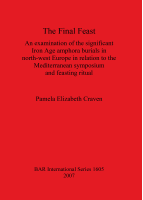Description
BOOK DESCRIPTIONIntrigued by this mundane, ubiquitous vessel, the author of this study began to collect data from amphora related burials with the intention of drawing parallels between Roman lifestyles and changing funerary practices in Gaul. As the data collection grew, it became apparent that not all of the burial contexts that contained amphorae qualified as élite burials. Some contained sherds rather than complete amphorae, together with potsherds and fragmentary goods. Convinced that sherd burials hinted at a localised tradition, details were added to the growing database of evidence. This study therefore aims to understand this relationship through interrogation of the reasons for the selection of amphorae and their treatment in the light of mortuary practice. While amphorae are still the key to this study, it is recognised that the significance of the vessels must be relative to cultural and social contexts; therefore the focus of this study widens from being a study of amphora in burials to a study of funerary behaviour and attitudes in which amphorae are incidental. The work is divided into three parts. The first section explores the development of feasting rituals in Iron Age Europe using the evidence of mythic literature, classical texts and iconography. Chapters 2 and 3 identify, describe, differentiate and analyse the feasting customs of Greek and Roman societies in order to lay a foundation for a comparative interpretation of Celtic or Gallic feasting ritual in Chapter 4. Chapter 4, as well as reviewing the classical observation of authors such as Tacitus and Strabo who describe the Gauls through Roman eyes, also introduces the corroboration of later Irish mythic in which 'Celtic' feasting plays a part. In Chapter 5 the textual sources are supported by the artefactual evidence of feasting vessels, furnishings and accommodation which were particular to feasting. Chapter 6 comments on the rise of powerful individuals and the social changes which may have culminated in a series of Gallic burials containing wine-related vessels. In part II three chapters are concerned with the disposal of both human and non-human material. Chapter 7 lists 265 Late Iron Age burials of Gallic Europe which contain amphorae, either in complete or sherd form. Though the initial recording of interments may have been included in a cemetery record, in this instance each burial is treated as a unique ceremony and is accorded an individual account. The amphora burials of the Champagne region are considered in full detail in Chapter 8. A body of evidence presenting similar ideology to that of amphorae burials is that of 'funerary' pits, which contain artefactual deposits associated with wine. These are considered in Chapter 9. Part III, the concluding Chapter 10, provides an interpretation of the assembled evidence, and attempts to justify conclusions.











